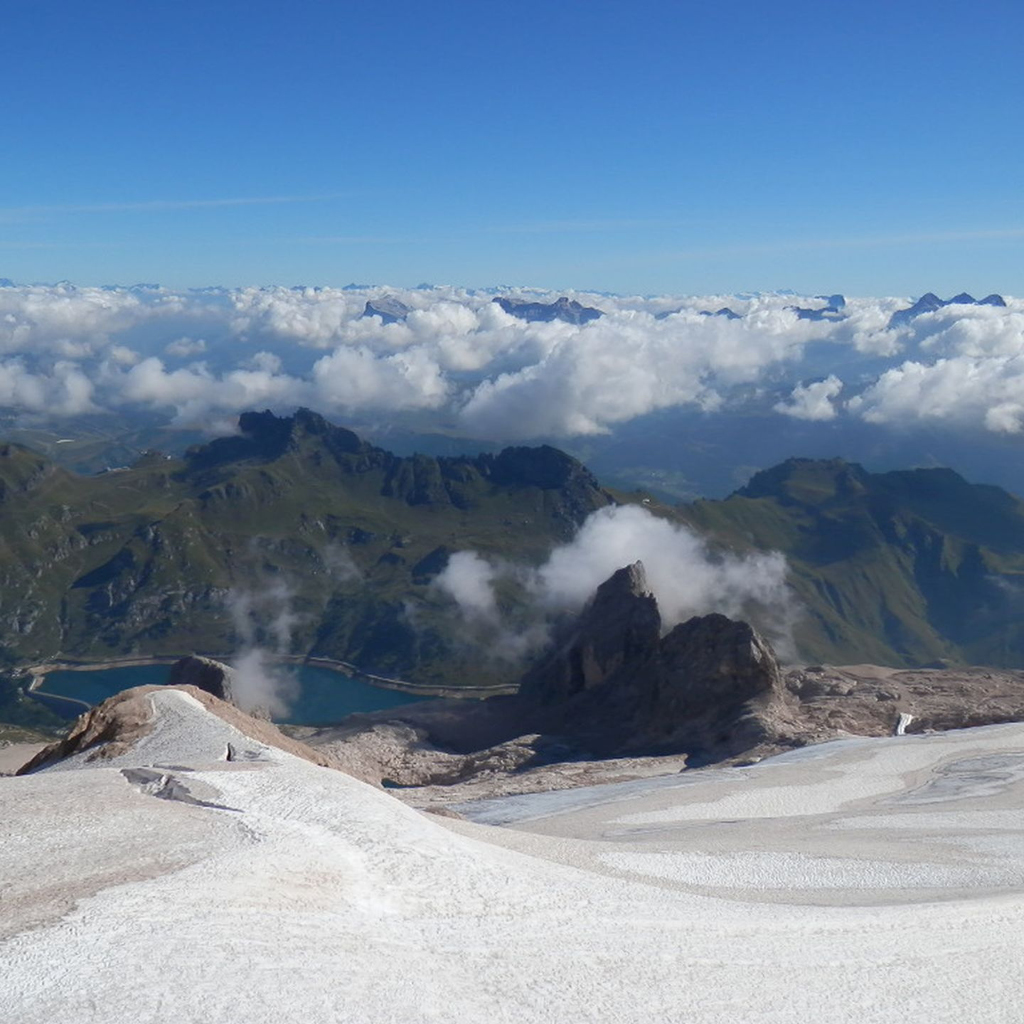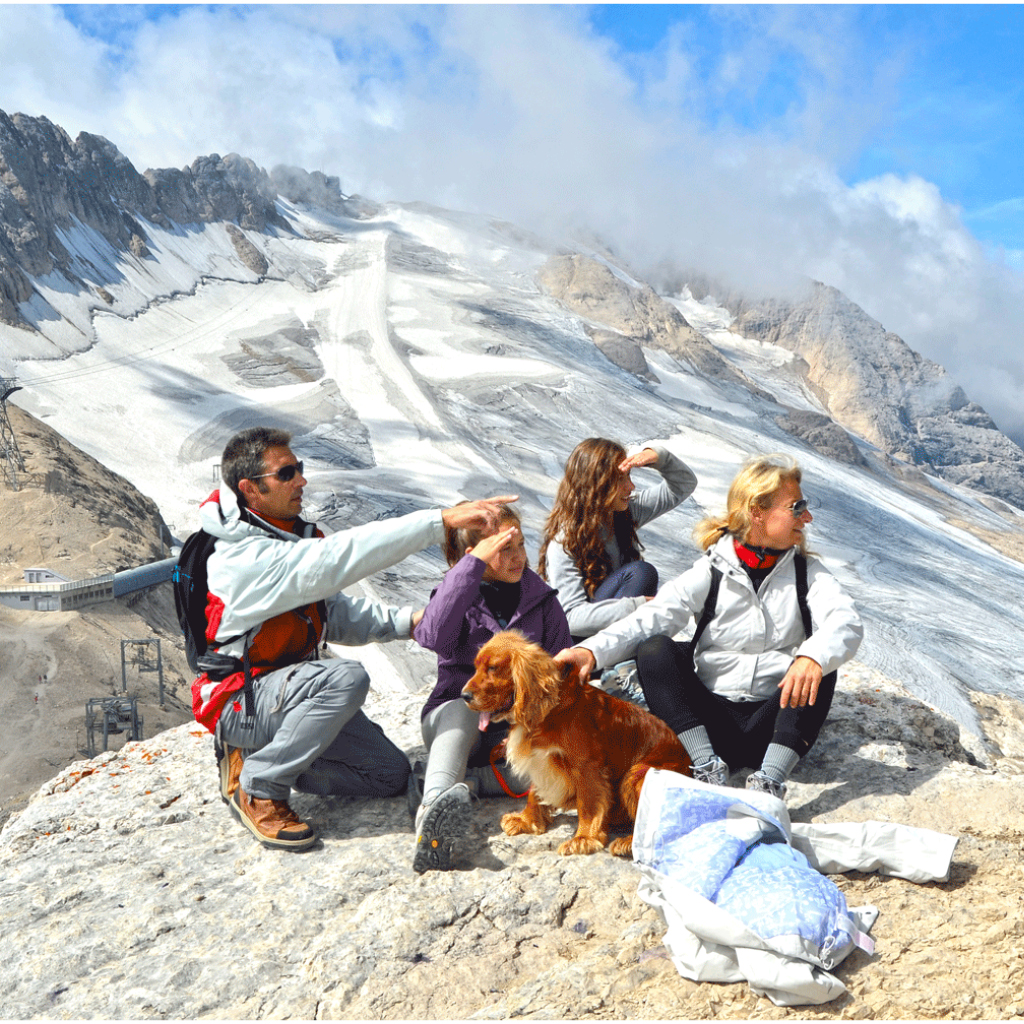THE MARMOLADA'S GLACIER YESTERDAY...
The Marmolada's glacier during the First World War played a key and strategic role, so that the Ten. Leo Handl, Guide Alpine Commander of the Austro-Hungarian army, during an exploration on the glacier, with his experience of engineer and soldier, designed a solution in order to solve the big problem of the provisions at the highest seats of war.
The seats of war, infact, were supplied through the surface of the glacer, above the rege of the adverse weather and the enemy fire. They also begun to escave a galleries network above the ice, which was called "Città di Ghiaccio".
Thanks to two galleries, that from the "City" went up to the rocky south wall, also the seats of war of Forcella Vu and the seats at 3259, were regularly provided with less risk and dangers. The dimensions of the galleries was about 2,5 m. large and 2 m. high.
In the beginning they were provided 8 km to connect the seats of war; with the creation of the "City" inside the glacier and following the extension of the project, the total lengh of the galleries grows up till 12 km. During the spring of 1917, this project was ended.
Often the crevasses openend and the soldiers overcome them with stairs and walksways. Other crevasses closed themselves, crushing the shacks, laboriously built. Thanks to the study of the moviments and to the decompression rooms, these problems were solved. This big brillant work, created by Leo Handl, saved many human lives.
In the beginning they were provided 8 km to connect the seats of war; with the creation of the "City" inside the glacier and following the extension of the project, the total lengh of the galleries grows up till 12 km. During the spring of 1917, this project was ended.
Often the crevasses openend and the soldiers overcome them with stairs and walksways. Other crevasses closed themselves, crushing the shacks, laboriously built. Thanks to the study of the moviments and to the decompression rooms, these problems were solved. This big brillant work, created by Leo Handl, saved many human lives.

... AND THE MARMOLADA'S GLACIER TODAY
During the winter season the Marmolada transforms in one of the most beautiful skiing area, with its 3.342 mt. it is the highest peak of the Dolomites. It give at the tourist the possibility to admire a unique landscape in the world.
With the car, it is possible to reach Malga Ciapela, where is the departure of the Marmolada's cable car. In only 12 minutes you will reach the top of the Dolomites's Queen and also the start of the most beautiful slope in the Dolomites.
The Marmolada lift is composed by two intermediate stations and on the second (Serauta - 2.950 mt.) there is the possibility to make a break in the bar/restaurant self-service. From the last station in Punta Rocca (3.265 mt.) people can start to skiing and also access to the biggest skiing area in the world throught the spectacular slope named "La Bellunese". It is the most longer in the Dolomites and it crosses the glacier till Passo Fedaia. From here, people can reach Malga Ciapela. There are 12 km. of slope with a very good width and an intermediate incline.
It is possible to make alpine skiing, snowboarding, cross country skiing, and free riding. Another good point to skiing is the near Padon 's area, which is ideal for all type of skier. There is also a ski school area which is perfect to begin this type of activity and suitable for all family needs. The present of the Scuola Sci and Snowboard Marmolada it is the synonymous of proffessionalism and it guaranties the maximum quality, not only ski lessons, but also for snowboarding, carving, telemark and funny daily trips through the Dolomiti Superski's slopes.
Malga Ciapela is also the ideal start point to beginning the Sellaronda ski tour or the Big War ski tour. They are the most suggestive ski tour in the Alps and the first passes across the Sella mountain through the famous 4 Dolomites passes: Campolongo, Gardena, Sella and Pordoi; the second it passes in the Marmolada, Civetta, Pelmo, 5 Torri, Tofana, Lagazuoi, Conturines, Settsass, Sassongher and Sella's areas. Along the way it is possible to admire the First World War's galleries. Both itineraries can be make easily in one day.
The ski mountaineering's itineraries are very interesting and spectacular. They give the possibility to reach an high altitude, where people can admire a wonderful landscape. The classics route include the Punta Rocca peak (the Marmoalda's second high peak) and Penia peak, reachable from Pian dei Fiacconi. It is also interesting the near areas, that start from Malga Ciapela, such as: Val Ombretta and Ombrettola, Val Franzèdas and Val Franzèi.
It is possible to make alpine skiing, snowboarding, cross country skiing, and free riding. Another good point to skiing is the near Padon 's area, which is ideal for all type of skier. There is also a ski school area which is perfect to begin this type of activity and suitable for all family needs. The present of the Scuola Sci and Snowboard Marmolada it is the synonymous of proffessionalism and it guaranties the maximum quality, not only ski lessons, but also for snowboarding, carving, telemark and funny daily trips through the Dolomiti Superski's slopes.
Malga Ciapela is also the ideal start point to beginning the Sellaronda ski tour or the Big War ski tour. They are the most suggestive ski tour in the Alps and the first passes across the Sella mountain through the famous 4 Dolomites passes: Campolongo, Gardena, Sella and Pordoi; the second it passes in the Marmolada, Civetta, Pelmo, 5 Torri, Tofana, Lagazuoi, Conturines, Settsass, Sassongher and Sella's areas. Along the way it is possible to admire the First World War's galleries. Both itineraries can be make easily in one day.
The ski mountaineering's itineraries are very interesting and spectacular. They give the possibility to reach an high altitude, where people can admire a wonderful landscape. The classics route include the Punta Rocca peak (the Marmoalda's second high peak) and Penia peak, reachable from Pian dei Fiacconi. It is also interesting the near areas, that start from Malga Ciapela, such as: Val Ombretta and Ombrettola, Val Franzèdas and Val Franzèi.
